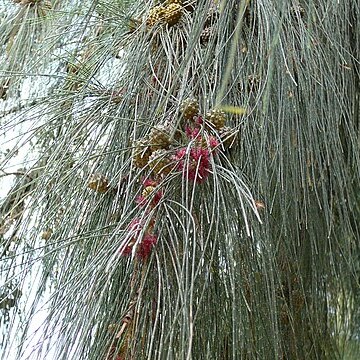Young persistent branchlets distinguished from deciduous branchlets by shorter segments and differences in shape or size of leaves; furrows deep and closed, concealing stomates. Infructescences pedunculate, pubescent at least when immature; bracts thin in exposed portion, not vertically expanded; bracteoles ± protruding from surface of infructescence, never greatly thickened, always lacking dorsal protuberance. Samaras pale yellow-brown or grayish, dull, glabrous. x = 9.
Trees or shrubs, monoecious or dioecious. Leaves in whorls, scale-like, connate, forming dentate sheaths. Inflorescences unisexual, catkin-like, the staminate ones elongate, the pistillate ones (sub)capitate. Flowers without perianth, subtended by bractlets; stamen 1; pistil 1, ovary unilocular, ovules 2, stigmas 2. Fruits one-seeded samaras, each enclosed by enlarged, more or less woody bractlets, aggregated into a cone-like infructescence.
Trees or shrubs. Deciduous stems with narrow grooves. Fruit bracteoles thick or thin, with or without dorsal protuberance; bracts relatively inconspicuous, not elaborately thickened. Samaras dark brown or black and shiny, or pale grey or fawn with surface pattern of minute slightly raised wavy lines.
Small to large trees. Lf-teeth in whorls of 5 or more; stomata borne within grooves of branchlets. Bracteoles of fruiting cones thin and without any dorsal protuberances. Samaras grey to tawny, dull.
Trees. Leaves (5 or)6-17 per whorl. Infructescence ("cone") bracteoles never greatly thickened, without an abaxial protuberance. Samara body pale yellow-brown or grayish, dull, glabrous.

